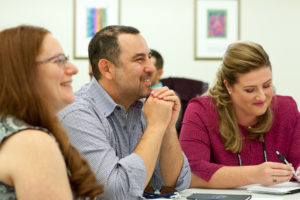Opinion
Classroom Laboratory
Learning from my Students
By Ray Levi
[This article is part of a series from the William Davidson Graduate School of Jewish Education of JTS, Student Voices: Perspectives on Critical Issues in Jewish Education]


JTS / Ellen Dubin Photography
During the last year, we have been asked to reinvent ourselves. As we adapt to the needs of remote learning, we have found ourselves in an environment of experimentation, engaging our student and family constituencies in the processes of trying new approaches, seeking feedback, and refining. While grieving what we are missing, I have also wondered, “What can we learn from these experiments that we might want to integrate into our more traditional practices?”
As director of the Day School Leadership Training Institute (DSLTI), I was invited to teach an asynchronous graduate class in school and nonprofit leadership. I realized I had a laboratory to explore these questions. I found myself hesitant about using a new platform that seemed so different from anything I’d worked with in the past. Building community has always been central to the work I do, and I wondered whether I could achieve the same critical goal. And yet, I also enjoyed the rush of adrenaline that comes with a new and adaptive challenge.
As the semester unfolded, I found my footing by falling back on the core principles that have always guided my work. In short, I learned that effective practices I’ve always employed in my teaching were adaptable to new platforms:
Seek guidance from those with more experience, particularly those who had taught asynchronous and hybrid courses in the past.
Seek feedback from students. When beginning a class on leadership, it was critical for me to share that this was my first time using this teaching platform. Whenever I had office hours, I left time for students to share their feedback. I created a discussion board for questions about the syllabus. As is often the case, even carefully considered questions and assignments were not nearly as clear to the students as I had hoped.
Build community by encouraging students to interact with one another and to be peer reader reviewers. On discussion pages, I asked students to respond to at least one comment offered by a peer. As I have done when teaching writing and oral presentation skills, I provided guidelines for giving feedback. The questions were simple: (1) What caught your attention in this piece? (2) What lingering questions do you have? (3) When the author makes revisions, what is one suggestion you’d offer?
Provide real life writing opportunities for students. I hoped that assignments would not simply be designed to meet course requirements. Through multiple writing projects, students articulated their professional mission, vision, and philosophy of educational leadership, informing their work in future positions. We regularly read eJewish Philanthropy and used it as a window into current issues in Jewish organizations. Being students of educational leadership encouraged reflection. Coursework designed to be shared in the larger community, could take their voices into larger conversations.
Provide opportunities to use multiple modalities and to draft and revise. With an opportunity to submit drafts, the role of teacher as a guide and coach was underscored.
Ask open ended questions that make room for students to connect theory to their own lives. Real dilemmas of practice were studied through analytical lenses, offering students perspective on issues that directly impacted their professional lives.
Beyond adapting past practices and learning new platforms, what are my takeaways – and better still, my surprises?
The quality and depth of online discussion: Each week students were asked to respond to readings or videotaped interviews on current issues. The comments more closely resembled journal entries or essays rather than the quick contributions of in-class discussions. I wanted students to know I was “listening,” but I was not needed to be an active facilitator. The conversations had many threads that achieved what is often the goal of class discussions, an atmosphere of informal, intense conversation around a table.
Online space supported vulnerability and risk-taking: Students respected the confidentiality of the group and acknowledged the emotional impact of difficult conversations while also providing strategies for addressing issues of working with supervisors, conducting performance evaluations, and tackling concerns related to gender and age.
Online interactions led to a desire for synchronous experiences: I had scheduled two Zoom small group sessions for each student, which were eagerly anticipated by the class. Students wanted to “meet” the people with whom they had been communicating, reminding me that there is always a place for more synchronous sessions.
There are multiple paths to community: I certainly did not expect that the highest ratings in student course evaluations would be in building community. Without minimizing what we can achieve through in-person and synchronous experiences, I am rethinking how I plan to build community in other settings that are currently remote. I have moved from a perspective of loss to one of greater opportunity.
After all of these learnings and takeaways, students were invited to focus on an issue of importance to them and write an eJewish Philanthropy article as their final project – some of which you will be reading in the coming weeks in Student Voices: Perspectives on Critical Issues in Jewish Education.
I honor the voices of the students who have guided me to unexpected understandings, by sharing their writing about important personal issues. It is written that from “all who would teach me, have I gained understanding.” For me, this could not ring more true.
Dr. Ray Levi is the director of the Day School Leadership Training Institute at the William Davidson Graduate School of Jewish Education of The Jewish Theological Seminary.











